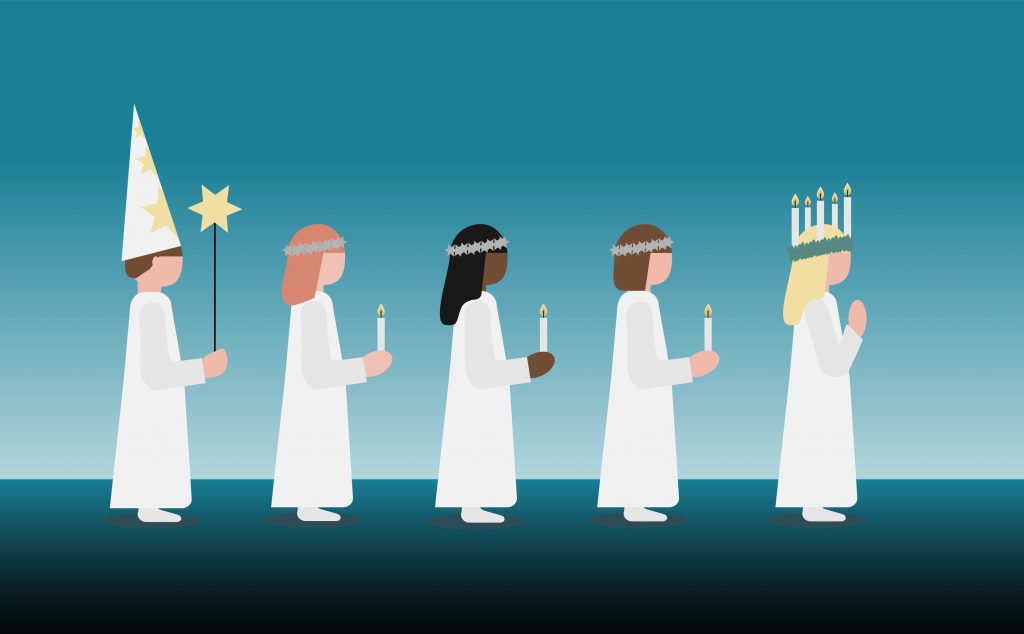Lucia // Saint Lucia
The 13th of December marks Saint Lucia’s Day. In Norway this day is tied to two stories. The story of the scary Lussi and the story of the holy Lucia.
The Scary Lussi
In the past people believed that the night between the 12th and 13th of December was the longest night of the year. This night became known as Lussi Long Night or Lussi Night. Now we know that the longest night of the year is around the 21st of December.
People believed that Lussi Long Night was magical. People believed, amongst other things, that animals could talk to each other during this night. Lussi Long Night marked the start of the Christmas period. Stories were told about Lussi who was a magical and dark figure. Lussi would check that everyone was well on their way with Christmas preparations. If tasks were not completed, she could come and scare people. If people were outside on Lussi Long Night then Lussi could even take them with her. That is why people stayed indoors on Lussi Long Night and made sure that the preparations for Christmas were started.
One of the tasks was baking. They used the spices saffron and turmeric so that the baked goods would get a nice yellow color. The yellow color reflects the candles that are lit on the long dark Lussi Long Night. The yellow color would also remind people that the dark times would be over soon and that the days would start to get lighter again.
Nowadays, buns are still baked with the spices saffron or turmeric for Saint Lucia Day on the 13th of December. These buns are decorated with raisins and are called “Lussekatter”.

Saint Lucia song
Activities about the text on Lussi
- Explain what Lussi Long Night is.
- Talk about who Lussi is.
- Why are people scared of Lussi?
- Draw what you think Lussi looks like.
- When is the longest night in the North?
- What are the buns called that are baked for Saint Lucia’s Day?
- What does the color of the bun dough symbolize?
Saint Lucia
The 13th of December marks Lucia Day when the Holy Lucia or Saint Lucia is remembered. The name Lucia comes from the Latin word “lux” which means light.
Lucia lived around the century 300 in Sicily in Italy. She was a Christian and believed in Jesus Christ. At the time, those who were Christian were persecuted by the Romans. Lucia was betrothed to a rich Roman man but she refused to get married. The rich Roman man got angry and felt hurt. He told those who were in power in the country that Lucia was Christian. She was therefore punished by the Romans and died a martyrs death. A martyr is someone who dies for their own beliefs.
There are many stories about Lucia’s kindness. Eventually, Lucia became a Christian Saint. At the time when Lucia lived, people who were Christian had to live in hiding. Some hid themselves in dark underground tunnels. They would attach candles to their heads to light up the inside of the tunnels. Christians thought of Lucia as the girl who knew the way to faith in what was a dark time.

In some places Saint Lucia Day is celebrated in schools and kindergartens. Children take part in the Lucia Day Parade and are dressed in white clothes. Usually, someone walks at the front of the parade with a wreath with candles on their head. The others follow behind and carry candles or stars in their hands whilst they sing the Lucia song. Parents and other guests are often invited to watch the Lucia parade. Afterwards, they eat “Lussekatter” together with the children.
Video showing the Lucia Day Parade
Activities about the text on Saint Lucia
- Tell us about what is celebrated on the 13th of December.
- Who do we remember on Saint Lucia Day?
- How is this day celebrated in Norway?
- What does the name Lucia mean?
- Do you know of any other days when we remember a person who has lived?
